
Get Stronger with Odd-load Kettlebell Training
StrongFirst Elite, CSCS, BExerSc, FMS2, GFM2
Life is unpredictable. So training that helps us withstand and react to asymmetrical loads and stresses goes a long way in making us more resilient. Kettlebells are perfect tools to help with that—especially when we add specialized odd-load varieties in our training. Not only are these moves great for those without matching doubles, but they are also fun ways to improve your versatility once you are proficient with one kettlebell or two equal-sized ones.
People love symmetry. It pleases the eye and resonates with our sense of aesthetics and beauty. We find symmetrical faces appealing and build symmetrical objects and structures. But symmetry doesn’t always make sense, especially when training to meet goals like improved performance, increased power, greater strength or enhanced stability.
Enter Odd-load Training
Why odd-load?
Because real-life strength is not about symmetry. Most of the time when we lift and carry something in everyday life, that object is neither symmetrical nor balanced. Think about picking up a piece of furniture or carrying your child on a hiking trail over uneven ground. Real-life strength is about our body being able to adjust to weight imbalances on a frontal and/or sagittal plane. It is practical but seldom developed in the gym. For example, very few people regularly train with an odd-load on a barbell.
Because we need to train anti-rotation patterns. According to Dr. Craig Liebensen, “Legs and hips generate the force, the core transfers the force, and the limbs release the force.” Odd-load training helps us to stabilize our whole torso through the transverse plane in order to generate and release force in other parts of our body.
Because we need to breathe in any position. Every breath we take is different, as our breathing mechanics have to constantly adapt to the shape of our ribcage. Odd-load training creates an additional demand that forces us to optimize our breathing under load.
Kettlebells: Perfect Odd-load Training Tools
Kettlebells are particularly well-suited for odd-load training—the only thing needed are two bells with enough weight difference to create the training adaptation. We can, therefore, apply odd-load training concepts to a wide array of fundamental hard-style kettlebell skills: the Deadlift, Swing, Clean, Squat, and Press. In each skill, it’s important to regularly alternate which hand holds the heavier kettlebell. Switch the bells on every set to equally distribute the training effect on both sides of the body.
Deadlifts
Odd-load Double Kettlebell Deadlift
The Deadlift is probably one of the first skills learned by a beginner girevik. Double kettlebell work adds load and steering strength since both arms have to stay connected independently. The Double Kettlebell Deadlift with different weights adds more load with upper-body-focused anti-rotational training and loading variety. It’s all about control— you have to raise both kettlebells at the same speed and keep them at the same level regardless of the weight difference.
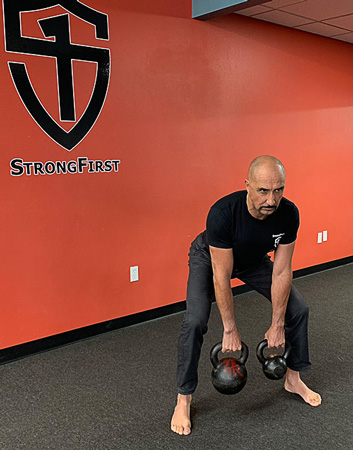
Odd-load Kettlebell Suitcase Deadlift
This movement adds anti-rotation training to the traditional Suitcase Deadlift and is, therefore, an additional option that sets the student up for movements such as Farmer Carries.
Odd-load Kettlebell Kickstand and One-leg Deadlift
Single-leg variations are in general the most difficult Deadlift skills, and prioritize anti-rotation, with an emphasis on the lower body. Single-leg variations of the Odd-load Kettlebell Deadlift simultaneously incorporate both upper and lower body anti-rotation training, a must for anyone who wants to get stronger in any position under load, as is often the case in contact sport and throws.
Odd-load Double Kettlebell Farmer and Rack Carries
These skills complement the Deadlift, with the additional demand of grip and/or wrist strength. When it comes to odd-load training, marching while in a Farmer or Rack Carry position also challenges torso stability.
Swings
Odd-load Double Kettlebell Swing
Double Kettlebell Swings are always more challenging. When you double the weight, you also need to double the control and timing. Odd-load training adds an anti-rotational component to the Double Kettlebell Swing, despite the fact that for this variation, you won’t be doubling the weight of the heavier bell as the other will be lighter. The greater the weight difference between the kettlebells, the more torso stability, and shoulder connection are needed. The goal is to keep both kettlebells at the same height at all times. From a practical standpoint, a four-kilogram difference is a minimum needed to see any neural adaptation. Because of the ballistic nature of the Swing, the body has to constantly adapt to the difference in the velocity of the two kettlebells.
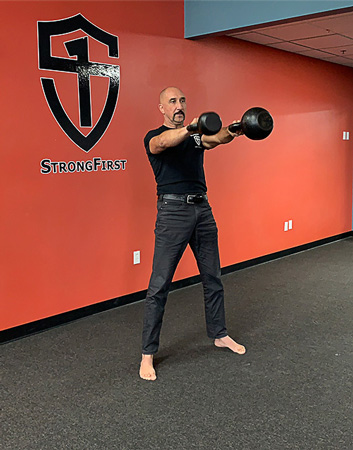
A quick mention here about the Odd-load Double Kettlebell Snatch. It is definitely a very advanced skill that should only be practiced by the most experienced lifters. Its ballistic nature creates a neuromuscular demand that beginner and many intermediate gireviks are not ready to withstand. Plus the odd-load component adds an anti-rotational element that needs to be properly mastered to avoid bad form and potential injuries.
Clean
Odd-load Double Kettlebell Clean
Similar to the Odd-load Double Kettlebell Swing, this exercise adds an anti-rotational element to an already complex hard-style kettlebell skill. Timing is everything in the Clean, and having to deal with two different-sized kettlebells increases the demand on the nervous system. As with the Odd-load Double Kettlebell Swing, the greater the weight difference between the kettlebells, the more torso stability, shoulder connection, and skill are needed.
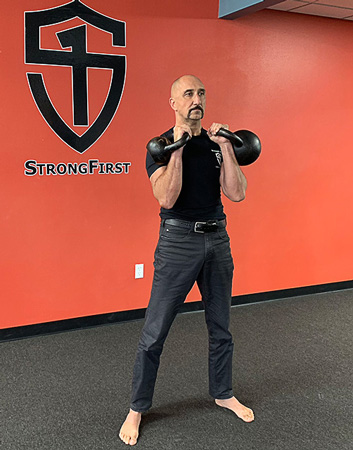
Squat
Odd-load Double Kettlebell Front Squat
One of the main challenges of the Front Squat is to preserve torso stability and shoulder connection throughout the movement. Lifting two different-sized kettlebells increases the need for control and stabilization. It becomes extremely easy to spot torso imbalances or insufficient lat activation. It is also one of those skills where being able to breathe optimally under an uneven load becomes critical.
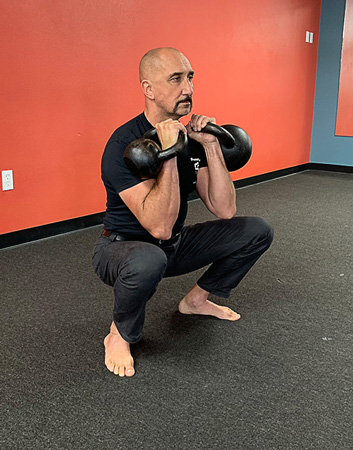
Odd-load Double Kettlebell Bottom-up Squat
This variation introduces grip and steering strength demands into the equation, increasing the neural load.
Press
Odd-load Double Kettlebell Military Press
When it comes to pressing two kettlebells overhead, their respective sizes play a huge factor in the neural, structural, and muscular adaptation of the lifter. Weight choice is critical, as it determines not only the ability to press with good form, but also the connection to the ground, the stability of the torso, and your control over its trajectory throughout the movement. The greater the difference between the two kettlebells, the more challenging it becomes to keep appropriate control and whole-body tension/integration.
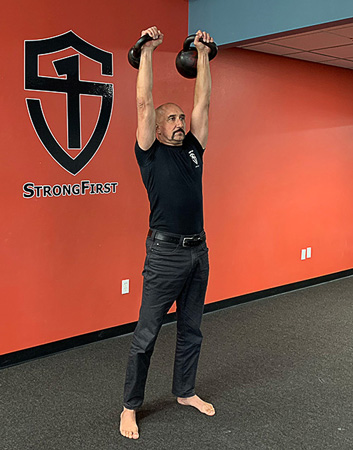
Odd-load Double Kettlebell Press Variations
See-Saw Press, Alternating Kettlebell Press, Half-Kneeling Double Kettlebell Press, and various Bottom-up Presses can all be part of your odd-load training arsenal. All these variations can become even more challenging when there is a larger difference in weight between the two kettlebells. Some of them will require more balance and coordination (i.e. Half-Kneeling Double Kettlebell Press), while others will be limited by grip strength (i.e. Bottom-up Press).
Odd-load Double Kettlebell Push Press and Jerk
Because of the more dynamic involvement of the legs compared to the Strict Military Press, the Push Press and the Jerk introduce an additional element of whole-body coordination and timing. Odd-load training enhances this effect by creating a left-right imbalance for the nervous system to factor in.
Putting Odd-loads into Practice: Three Protocols
Here are three ideas on how to implement odd-load training into your or your students’ practice. The first one is for beginners, the last two for more advanced practitioners.
Lift and March
Equipment: 2 heavy kettlebells of different sizes
Skills: Double Kettlebell Deadlift, Suitcase Deadlift, Kickstand Deadlift, Farmer Carry, Marching
Protocol:
- Round 1: Double Kettlebell Deadlift x 5, followed by 30 seconds of Farmer Carry while Marching
- Round 2: Switch the kettlebells to the other side > repeat round 1
- Round 3: Switch the kettlebells to the other side > Double Kettlebell Suitcase Deadlift x 5, followed by 30 seconds of Farmer Carry while Marching
- Round 4: Switch the kettlebells to the other side > repeat round 3
- Round 5: Switch the kettlebells to the other side > Double Kettlebell Kickstand Deadlift x 5, followed by 30 seconds of Farmer Carry while Marching
- Round 6: Switch the kettlebells to the other side > repeat round 5
- Rest as appropriate between rounds.
The Three Twins
Equipment: 3 kettlebells—two of the same size, one 4kg heavier (increasing the gap increases the difficulty)
Skills: Double Swing, Double Clean, Double Press (or Push Press, or Jerk depending on the lifter’s experience and skill level), Double Squat
Protocol:
- Each round is 3 repetitions of Double Swing, Double Clean, Double Press, Double Squat
- Round 1: Heavy kettlebell on the right side, light kettlebell on the left
- Round 2: Two same size kettlebells
- Round 3: Same as round 1 except heavy kettlebell on the left side, light kettlebell on the right
- Rest two minutes between each round. Repeat as desired.
Up and Down the Odd Ladder
Equipment: 4 kettlebells of consecutive sizes placed in a row from kettlebell #1 (the heaviest) to kettlebell #4 (the lightest)
Skills: Double Clean, Double Squat
Protocol:
- 1st ladder: The heavier kettlebell is always on the right
- Round 1: 1 repetition of Double Clean and Double Squat with kettlebell #1 (the heaviest) on the right and kettlebell #2 (the next heaviest) on the left
- Round 2: 3 repetitions of Double Clean and Double Squat with kettlebell #2 on the right and kettlebell #3 on the left
- Round 3: 5 repetitions of Double Clean and Double Squat with kettlebell #3 on the right and kettlebell #4 on the left
- Round 4: 3 repetitions of Double Clean and Double Squat with kettlebell #2 on the right and kettlebell #3 on the left
- Round 5: 1 repetition of Double Clean and Double Squat with kettlebell #1 on the right and kettlebell #2 on the left
- Rest 30 seconds to 1 minute between each round, depending on the level of exertion. Rest at least two minutes before the second ladder
- Repeat the ladder a second time, this time with the heavier bell always on the left.
Using double-but-unequal kettlebells offers the opportunity to add resilience to your strength. Enjoy your Odd-load training!

